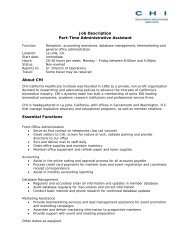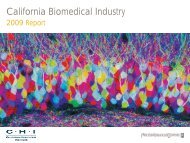<strong>California</strong> <strong>Biomedical</strong> <strong>Industry</strong> Defined<strong>California</strong> <strong>Biomedical</strong> <strong>Industry</strong>Report HighlightsNumber of <strong>California</strong> biomedicalcompanies:2,244Total estimated revenues:$114 billionTotal estimated employment:267,772Total estimated wages and salariespaid: $19.4 billionAverage annual biomedical industrywage: $72,332Total NIH grants awarded:$3.2 billionTotal estimated venture capitalinvestment in <strong>California</strong> biomedicalcompanies:$2.6 billionTotal biomedical exports:$15.4 billionWhat is an industry? The Googledictionary suggests various definitions:a particular branch of economic orcommercial activity; a domain inwhich a great deal of time and effortis expended; and, simply, “hardwork.” Actually, all of these apply to<strong>California</strong>’s biomedical industry, abroad, diverse field that encompassesscientists, engineers, entrepreneurs,manufacturers, marketers and, as thisreport makes clear, almost every typeof professional. What ultimately bringsthe industry together, though, is acommon purpose: innovation of bettermedicines, tests and treatments forpatients in need.Despite the rapid proliferation ofbiotech and medical technology aroundthe world, <strong>California</strong> remains theindustry’s global leader. Over the pastdecade or so, as other states and nationshave striven to discover the secret tocreating high-tech jobs, <strong>California</strong>’sbiomedical clusters – from the BayArea to San Diego – have been studiedintensely. How did biotechnologyoriginate in San Francisco? Whatconditions enabled the new science toflourish? How did basic research makethe great leap to successful commercialdevelopment? And, perhaps mostimportant of all, what has made thestate’s biomedical industry sustainablein the face of growing competition?The answers are not simple. Afterall, there was no master plan; theindustry grew organically within theunique conditions of the <strong>California</strong>environment. What is evident inretrospect, however, is that the stateconstitutes an extraordinary ecosystemin which many different elementswork together, spawning at differenttimes Hollywood, Silicon Valley and,most recently, the biomedical industry.Some of the essential elements areeasy to name. Leading-edge science;experienced venture capital; a diverse,well-educated workforce; a group ofserial entrepreneurs. But others aremore subtle. A culture that appreciatesrisk takers and that does not penalizefailure; healthy skepticism about timehonoredinstitutions; freedom to ignoreboundaries.Looking at today’s lifesciences industry, one seesamazing variety and dynamicconvergence.Traditional categories within the lifesciences have blurred because scientistsare venturing into ever more complexspace. What used to be the realm ofchemists and clinicians has expandedto include engineers, mathematicians,biologists, software designersethicists, and architects. Researchersare pursuing diseases to their rootcauses, below the cellular level, tounderstand the molecular triggers forgene expression. Doctors and engineersare collaborating to embed advancedwireless technologies in medical devicesthat can manage diabetics’ insulin levelsor cardiac patients’ arrhythmias moreprecisely, and with better outcomes,than anyone a decade ago could haveimagined.And the players keep changing roles.Physicians become researchers,and scientists become companyfounders. Legislators become patientadvocates, and math majors becomebiostatisticians. Most are driven by apassion to make a difference, and whenthey see a way to make a more lastingimpact or to improve people’s lives, theychange course.Just as technology is closing the gapsbetween people in their daily lives, it isrevolutionizing public health. In a worldwith five billion cell phones, almosteverybody — physicians, researchers,investors, caregivers, patients andinterested bystanders — has access tomore information and more ways toconnect with others who have similarinterests. Patients are taking moreresponsibility for their own treatmentsand health. Specialists are reading MRI4 | <strong>California</strong> <strong>Biomedical</strong> <strong>Industry</strong> 2011 Report
scans from patients a continent away.Volunteers are safely testing for HIV/AIDS and tuberculosis in regions thatnever had established labs. In a worldwhere access to digital information,instant analysis and transmission ofdata are almost free, it is clear thatthe biomedical industry is poised forincredible transformation.At the center of this transformation arethe 268,000 <strong>California</strong>ns employed inthe state’s basic research institutionsand commercial life sciences companiesTogether they are seeking answers tothe mysteries of diseases, from the mostcommon infections to the rarest tumors.This report describes current work andrecent advances in oncology, centralnervous system disorders, infectiousdisease, immunologic and inflammatoryconditions, cardiovascular disease, anddiabetes and other metabolic diseases.for biotech, has experienced flat ordeclining valuations based on questionsabout its capacity to produce newdrugs. While there is great hope for anew era of personalized medicine, itremains unclear how the changes in thebiomedical industry’s healthcare systemera necessary for its growth will unfold.Meanwhile the state of <strong>California</strong>struggles with high unemploymentand a massive budget deficit thatconstrain policymakers’ choices. In thecase of the state institutions of highereducation, the financial crisis continuesto worsen. The UC system cut expensesand programs, capped enrollments andimplemented system-wide furloughsto close a $813 million budget gap in2009-2010 — a gap predominantlyopened by the state’s inability tomeet its commitments to the system.According to the <strong>California</strong> LegislativeAnalyst, the projected UC systemshortfall for 2010-2011 is $1 billion,and there is no relief in sight. The CSUsystem and community colleges aresimilarly stressed, as is <strong>California</strong>’s K-14education budget.The truth is, there is no long-termsolution to <strong>California</strong>’s predicamentexcept job creation and a new waveof economic growth. The state’sbiomedical industry has made animportant contribution to the <strong>California</strong>economy and, for reasons this reportexplains, is well-positioned to play aneven greater role in the future. Butthe competition is fierce and growingfiercer. For policymakers, the firststep toward a solution is an accurateassessment of the present situation.And for the life sciences industry, that isthe purpose of this report.As detailed in this report, <strong>California</strong>’sbiomedical industry has built anamazing array of state-of-the-artresearch facilities and centers. It hasestablished collaborative networksdesigned to accelerate translationalresearch — to put basic researchdiscoveries to work for patients asquickly as possible. It has erectedand continues to build specialfacilities to promote collaborationamong researchers, clinicians andentrepreneurs.Still, as Shakespeare put it, what’s pastis prologue. Whether the remarkable,unplanned success of <strong>California</strong>’sbiomedical sector can carry on inthe decades to come is an openquestion. The aftershocks of the GreatRecession continue to reverberate.Availability of capital, especially forstartups, is extremely limited as themarket’s appetite for risk is reduced.The business model that producedhundreds of biotech and medical devicefirms – early-stage venture funding,followed by an initial public offering(IPO) of stock – is seriously fractured.And the pharmaceutical industry,which for decades served as an anchor<strong>Industry</strong> sectorsThe <strong>California</strong> biomedical industry spans the full range of innovative research andtechnological development aimed at improving human health and the quality of lifefor patients around the world.Basic research adds to the body of scientific knowledge. <strong>California</strong>’s universitiesand public and private research centers train scientists, engineers and technicalspecialists. They provide research space, equipment and resources for ongoingresearch. And they fuel the state’s legacy of innovation via technology transfer andthe formation of spin-off companies.Biopharmaceuticals is the product category that includes human therapeutics— drugs — whether small-molecule chemical compounds, biologics (geneticallyengineered proteins) or cell therapies.Diagnostics are technologies that diagnose and characterize patients’ conditions.From simple, “old school” tools such as home test kits to computerized equipmentto map a patient’s genome, diagnostics are essential in providing correct diagnosesand informing treatments for the best possible outcomes.Medical devices are tools for improving or diagnosing human health and mobility.The term medical technology or “medtech” covers everything from medicalprofessionals’ instruments to devices patients use to improve mobility or function, toimplants to replace or reinforce damaged or faulty body parts.Laboratory services are those service providers that test patients’ or researchsamples with precisely calibrated and strictly regulated equipment and proceduresto ensure accurate results.Wholesale trade companies manage the import, export and exchange ofpharmaceuticals, medical devices, diagnostics and research reagents and othersupplies in the global market.<strong>California</strong> <strong>Biomedical</strong> <strong>Industry</strong> 2011 Report | 5






